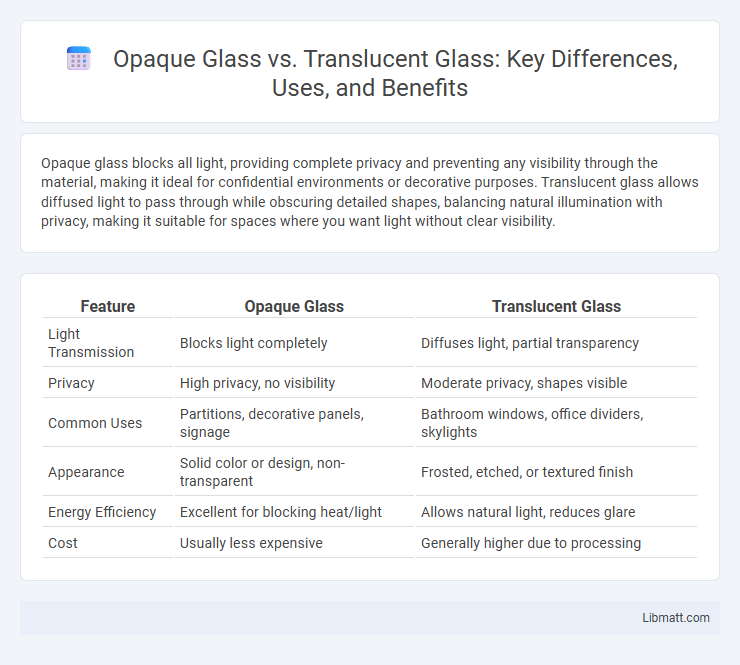Opaque glass blocks all light, providing complete privacy and preventing any visibility through the material, making it ideal for confidential environments or decorative purposes. Translucent glass allows diffused light to pass through while obscuring detailed shapes, balancing natural illumination with privacy, making it suitable for spaces where you want light without clear visibility.
Table of Comparison
| Feature | Opaque Glass | Translucent Glass |
|---|---|---|
| Light Transmission | Blocks light completely | Diffuses light, partial transparency |
| Privacy | High privacy, no visibility | Moderate privacy, shapes visible |
| Common Uses | Partitions, decorative panels, signage | Bathroom windows, office dividers, skylights |
| Appearance | Solid color or design, non-transparent | Frosted, etched, or textured finish |
| Energy Efficiency | Excellent for blocking heat/light | Allows natural light, reduces glare |
| Cost | Usually less expensive | Generally higher due to processing |
Understanding Opaque and Translucent Glass
Opaque glass blocks light completely, providing full privacy and preventing visibility through the surface, making it ideal for areas requiring maximum confidentiality. Translucent glass allows light to pass through but diffuses it, creating a blurred effect that maintains privacy while still illuminating your space. Understanding these differences helps you choose the right glass type for your design needs, balancing light transmission and privacy.
Composition and Manufacturing Differences
Opaque glass is formulated with added metal oxides or pigments such as titanium dioxide or iron oxide during the molten stage, blocking light completely, while translucent glass contains fewer or no such additives, allowing diffused light to pass through. The manufacturing process for opaque glass typically involves mixing these opacifying agents evenly into the glass batch before melting, whereas translucent glass undergoes careful control of raw materials and annealing to maintain clarity without full transparency. Understanding these differences helps you select the appropriate glass type based on light transmission and aesthetic requirements.
Light Transmission Capabilities
Opaque glass blocks nearly all light transmission, providing complete privacy and minimizing glare, making it ideal for spaces requiring darkness or confidentiality. Translucent glass allows diffused light to pass through, offering natural illumination while obscuring clear visibility, which enhances privacy without sacrificing brightness. The choice between these glass types hinges on balancing light control with privacy needs in architectural and design applications.
Privacy and Security Features
Opaque glass offers superior privacy and security by completely blocking visibility, making it ideal for confidential spaces or rooms requiring full discretion. Translucent glass allows light diffusion while obscuring detailed views, providing moderate privacy suitable for areas where light transmission is important but some level of concealment is desired. Your choice between opaque and translucent glass should balance the need for maximum security against the desire for natural light and visual comfort.
Aesthetic and Design Options
Opaque glass offers a bold and solid appearance, providing complete privacy and allowing designers to create sleek, modern designs with strong visual impact. Translucent glass diffuses light softly, enhancing spaces with a subtle glow while maintaining some privacy, making it ideal for minimalist and contemporary interiors. Your choice between opaque and translucent glass significantly influences the ambiance, lighting effects, and overall aesthetic appeal of a project.
Common Applications in Architecture
Opaque glass is commonly used in architectural elements requiring privacy and light blockage, such as bathroom windows, office partitions, and building facades. Translucent glass allows diffused natural light to penetrate interiors while maintaining privacy, making it ideal for skylights, conference rooms, and decorative walls. Your choice between opaque and translucent glass depends on the balance you need between illumination and privacy in your architectural design.
Energy Efficiency and Insulation
Opaque glass offers superior energy efficiency by blocking more sunlight and reducing heat transfer, making it ideal for minimizing cooling costs in warmer climates. Translucent glass provides moderate insulation by diffusing natural light while still limiting heat loss, balancing daylighting with thermal performance. Choosing between opaque and translucent glass depends on specific insulation needs and desired natural light levels for energy savings.
Maintenance and Cleaning Requirements
Opaque glass requires less frequent cleaning due to its non-transparent surface that conceals fingerprints and smudges, making it ideal for high-traffic areas. Translucent glass demands regular maintenance to preserve its light-diffusing properties and remove visible dirt or streaks that can affect clarity. Both types benefit from gentle, non-abrasive cleaners to avoid surface damage and ensure longevity.
Cost Comparison: Opaque vs Translucent Glass
Opaque glass generally costs less than translucent glass due to simpler manufacturing processes and fewer specialized treatments. Translucent glass often requires advanced techniques such as frosting, sandblasting, or chemical etching, increasing production expenses. Your choice between opaque and translucent glass will impact overall project costs, with translucent options typically commanding higher prices for enhanced light diffusion and privacy features.
Choosing the Right Glass for Your Project
Choosing the right glass depends on the desired balance between privacy and light transmission, with opaque glass offering complete privacy by blocking visibility and translucent glass allowing diffused light while maintaining partial privacy. Opaque glass is ideal for areas requiring full concealment such as bathroom windows or office partitions, whereas translucent glass suits spaces needing soft natural light without clear views, like conference rooms or interior doors. Understanding the functional and aesthetic needs of your project ensures optimal selection between opaque and translucent glass types.
Opaque glass vs translucent glass Infographic

 libmatt.com
libmatt.com